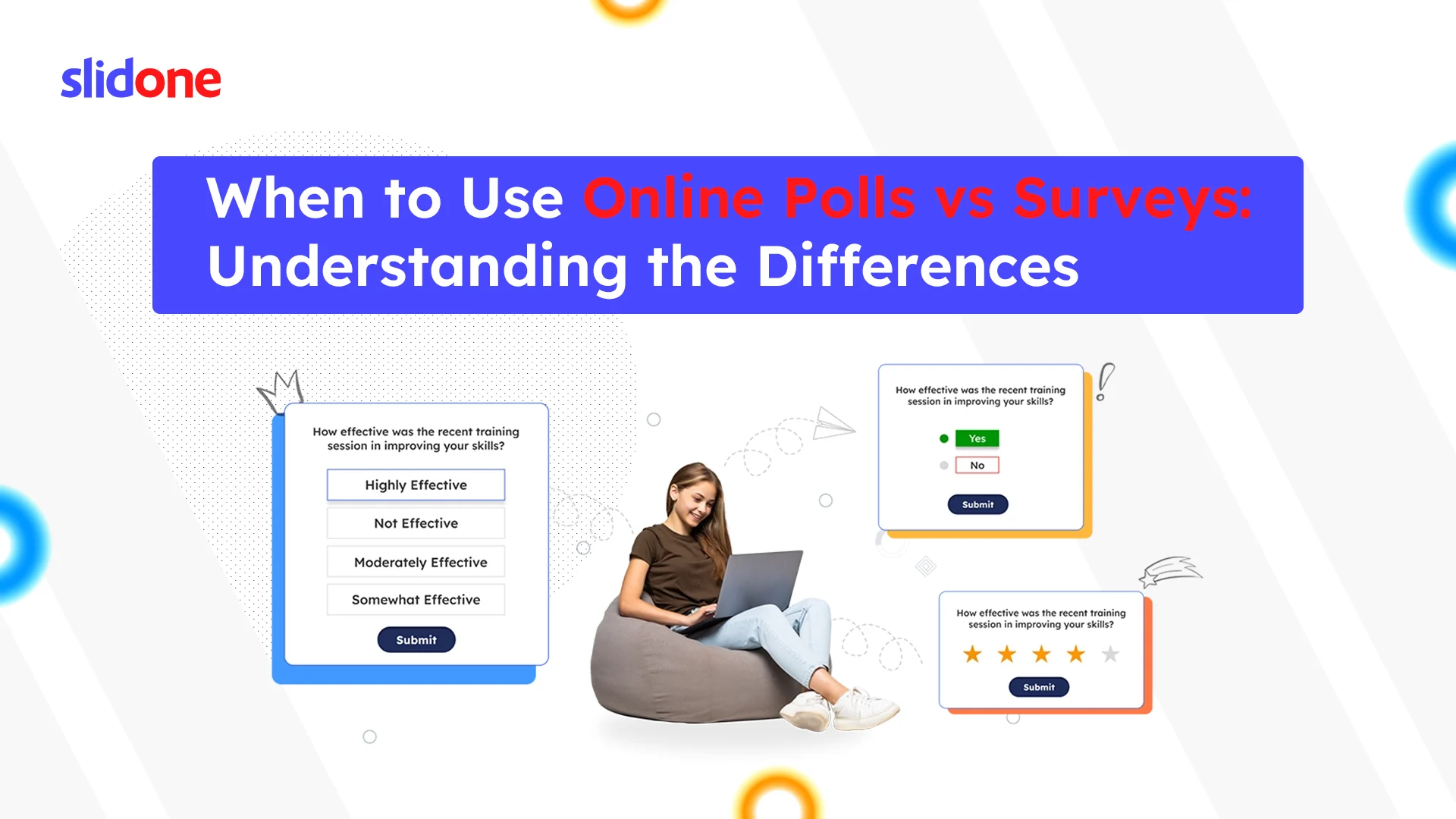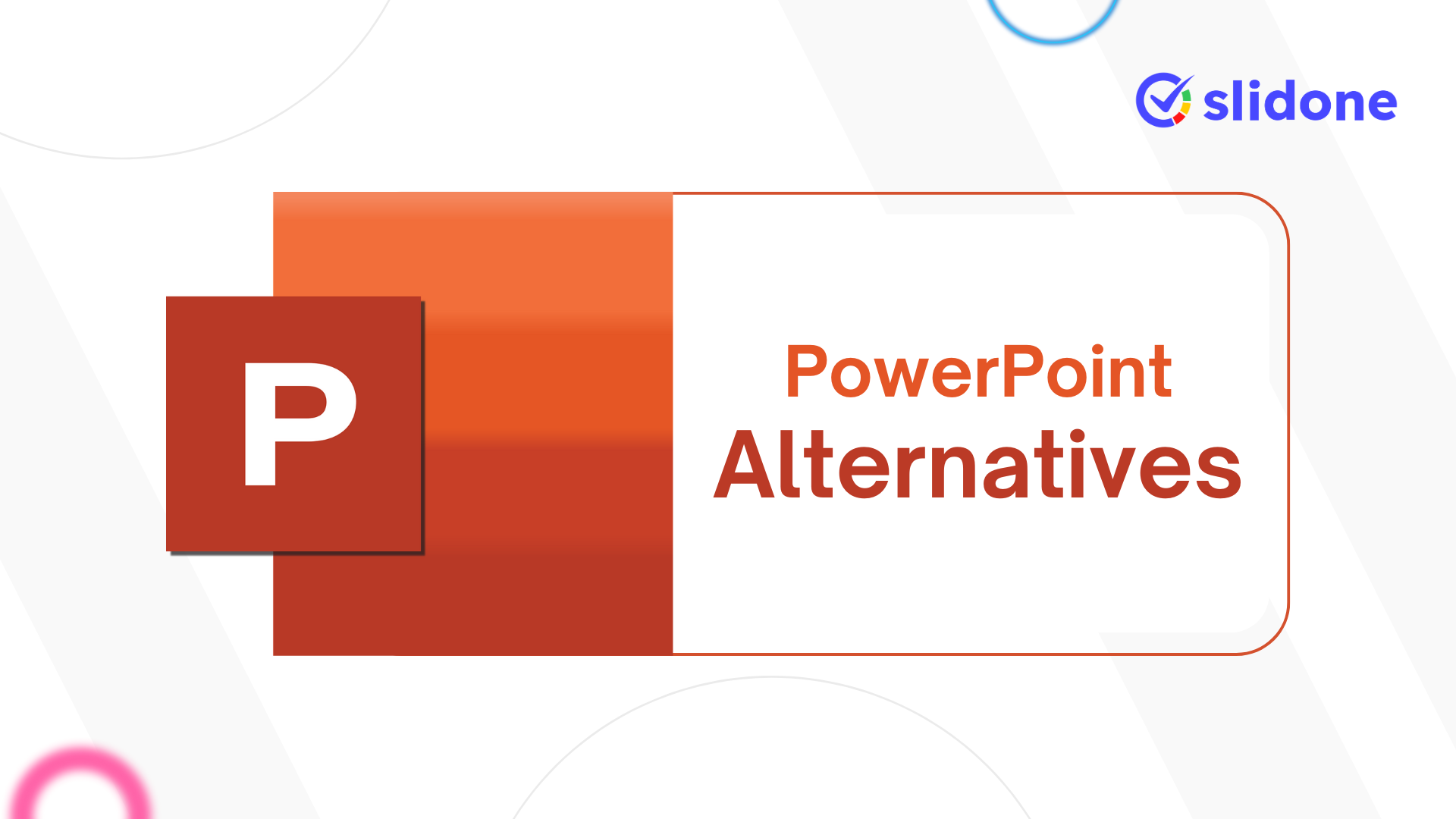In our digitally connected world, gathering feedback, opinions and data has never been easier. Online polls and surveys have become popular tools for gathering insights in the classroom, at work, or even among friends. But when should you use live polls, and when is an interactive survey a good strategy? While both methods are valuable, they serve different purposes and are superior in different circumstances. This blog will explore the key differences between online polls and surveys, help you understand when to use each, and provide practical tips for getting the most out of these tools.
What Is an Online Poll?
Online polls are a quick and easy way to gather the opinions of a group of people on a particular question. Generally, a poll is a question with a number of answer options, such as “yes” or “no” or a few multiple choice options. Polls are often used in real time, such as during a live presentation session, to quickly gauge audience opinion or preference.
For example:
An instructor could use an online poll during class to ask, “Do you find this lesson easy to understand?”. including options such as “yes” or “no”.
The company can use polls at meetings to decide when the team will visit, with options such as “morning”, “afternoon” and “evening”.
What Is a Survey?
Surveys, on the other hand, are more of a comprehensive method of data collection. Surveys typically have multiple questions and can cover a wide range of topics. Different types of questions can be used, such as multiple-choice, open-ended, and qualitative questions. Surveys are generally used when you want to dive deeper into a topic and gain a broader understanding of people’s opinions or experiences.
For example:
A school can use a survey to gather feedback from parents on how they feel about distance learning, as well as questions about their experiences, challenges and suggestions for improvement.
A company can send customers a survey to learn more about satisfaction with a recent product or service by asking detailed questions about their experience.
Key Differences Between Polls and Surveys
While online polls and surveys are valuable for gathering information, there are some key differences in terms of their purpose, design, and type of information Let’s take a closer look at these differences:
1. Purpose and depth
Polls: Polls are ideal for quickly gathering information or gauging opinions on a topic. Because they focus on a single question, they are ideal for situations where you need a simple answer or a general understanding of how people feel about the topic. Polls provide a snapshot of ideas, making them great for immediate feedback.
Surveys: Surveys have been conducted in order to gather more in-depth data. Multiple questions that explore the topic from different angles can be included. This makes surveys ideal when you want to gain a deeper understanding of people’s experiences, habits, or preferences. Surveys can provide detailed insights that help you make informed decisions.
2. Question structure
Polls: Most online polls use a single multiple-choice questionnaire. The focus is on providing respondents with a few options, such as “yes,” “no,” or a few specific options. This simplicity also makes it quick and easy to answer polls.
Surveys: Surveys provide a wide variety of questions, including multiple choices, rating scales (such as 1 to 5 stars), open-ended questions, etc. This flexibility allows survey researchers to collect quantitative and all aspects of quality. For example, the survey might ask respondents to rate their satisfaction on a scale of 1 to 10 and then ask them to describe their rating with an open-ended question
3. Length and Time Commitment
Polls: One advantage of polls is that it is short and takes very little time to complete. Respondents can answer a poll in a matter of seconds, making it easy to gather a large number of responses quickly. This is especially useful when you want to engage them in an ongoing process or need immediate feedback.
Surveys: Surveys are long and take a lot of time to complete. Depending on the number and complexity of questions, respondents may also need several minutes or more to complete the survey. Thus, surveys are best suited for situations where participants are willing to spend a little extra time providing detailed information.
4. Audience engagement
Polls: Polls are best for real-time audience engagement. They are often used in presentations, webinars, or seminars to get audience participation and gather feedback on the spot. For example, the presenter can use a poll to ask the audience about the topic and display the results immediately.
Surveys: Surveys are often shared after an event or activity to gather information or conduct research. Typically, they are submitted via email, social media, or online forums, and respondents complete them at their convenience. While surveys are not as immediate as polls, they do allow for more considered and considered responses.
5. Data analysis
Polls: Because polls focus on one question, analyzing the results is easy and straightforward. You can quickly see how many people chose each option and calculate the percentage to understand the overall mood.
Surveys: Surveys yield more complex data, especially if they contain a mixture of questions. In analyzing research results, one can look for patterns, trends, and themes in the responses. Surveys generally require more time to analyze, but can provide deeper insight into the issues under investigation.
How to Create Online Polls and Surveys?
Creating online polls and surveys is easier than ever, thanks to various user-friendly platforms like Slidone. These tools allow you to design polls and surveys that are both visually appealing and effective in gathering the feedback you need. Whether you’re an educator looking to engage your students or a business looking for consumer insights, the following steps will guide you through creating an online poll or a survey:
1. Choose the right platform:
Start by choosing interactive presentation tools that meet your needs. For example, Slidon is ideal for creating interactive polls and surveys with a variety of options available. Other popular options include Google Forms, SurveyMonkey, and Typeform. When choosing your platform, consider factors such as ease of use, customization options, and the ability to analyze feedback.
2. Define your goals:
Think about what you want to achieve before you create a poll or survey. Is your goal to quickly gather information during a meeting, or do you need a more comprehensive view of customer satisfaction? Defining your objectives will help you decide whether polls or surveys are the best option and ensure your questions are appropriate.
3. Right Questions:
Design your questions in clear, simple English. In case of a poll, direct all your attention to one question and have a very straightforward response required for it. For a survey, you can provide several questions, but ensure that the language is not over the top. Make sure all the questions are very directly related to the information you want to collect.
4. Appropriate Question Type:
Choose the kinds of question types that suit your needs. When administering a survey or poll, you would mainly use the multiple-choice type. When you are using other kinds of surveys, you could combine different types of questions: multiple choice, rating scale, open-ended, and yes/no. This will keep those who give responses interested, and you will get richer data.
5. Personalize the Look:
Add a personal touch to your poll or survey by making it match your brand or theme. Most platforms enable color adjustments, fonts, and background changes, so it will look appealing. If you are conducting the survey in a classroom or entertaining setting, adding relevant images or themes can add to the fun of the experience for those participating.
6. Test your poll or survey:
Before you let your audience respond to your poll or survey, test it out yourself or try it with a few of your colleagues or friends. Testing out the poll or survey will help you catch any errors or confusing questions so that the poll or survey works like a dream across different devices.
7. Share with your audience:
After finalizing your poll or survey, share it with your target audience. Most of the sites give options to share in different ways such as generating a link, embedding the poll into a website, sharing via social media and email. To get instant engagement, you may conduct a poll during a live presentation or meeting and request the audience to vote using their mobile phones.
8. Interpret Results:
After you have collected your responses, take some time to analyze the results. Most online platforms provide data visualization tools, like charts and graphs, to help understand the responses quickly. Start with a thread of trends and patterns and common themes in the data so that insights can be gained and better, informed decisions made from such feedback.
9. Follow Up:
If you use surveys to seek feedback, consider then reaching out to those you have surveyed to thank them for their participation and how their feedback will be used. This encourages trust and shows you appreciate their opinion, which can also make participation in future polls or surveys a good idea.
When to Use Online Polls?
Now that we understand the differences between polls and surveys, let’s explore when to use each tool. Here are some situations where online polls are the best choice:
1. Live Events or Meetings:
Polls can be used during interactive live events, including webinars and virtual meetings as well as classroom sessions. A teacher might even go ahead and conduct a poll asking a question such as, “Did you find today’s lesson helpful?” reflecting the results immediately. In this way, students keep track of what is happening while also enabling the teacher to come back and adjust if they need to.
2. Swift Judgment:
Use polls in the situation where you need to make a quick decision based on group input. Suppose your team needs to decide on a date for a meeting or a preferred location for an outing; a poll can quickly gather everyone’s preference and lead you to making a decision
3. Collect opinions on one issue:
If you want to survey opinions about a single question, ask “Do you favor increased recess time?” or “Pizza or sandwiches for lunch?” Then a poll is the appropriate tool. It’s really just a snapshot of where most people stand on a single issue.
4. Turn on Social Media Audiences:
It is great to use polls to engage with your followers on social media. Most of the social media websites, like on Twitter and Instagram, have these poll features that allow you to post a question to your followers for answers to appear immediately. It is a wonderful way of keeping your audience active and involved.
When to Use Surveys?
Surveys are best used in various situations because they can acquire deeper information. Among these situations, the following best describe the ideal usage of surveys:
1. Conducting Detailed Research:
A survey is the way to go if you need comprehensive insight into any given topic. For instance, a school may apply a survey when garnering opinions of parents on their satisfaction with remote learning. The survey may include queries on challenges, benefits, and suggestions for improvements, where the school would gain essential information it could use when adjusting things.
2. Feedback from Customers
Businesses often use surveys to figure out what their customers really think about their products or services. A survey might consist of several questions related to customer satisfaction, features, and overall experiences with a business’s product. This helps businesses identify strengths and weaknesses.
3. After-Event Feedback:
A survey can also be organized after hosting an event, for example after a conference or a workshop. The attendees can then have a say in what they enjoyed, what needs improving, and if they would attend the same events again. Unlike polls, surveys are more detailed forms of feedback.
4. Measuring Employee Satisfaction:
HR departments may also consider resorting to surveys in determining the satisfaction and engagement of the employees. The questions to ask them may range from a sense of work environment, job satisfaction, to suggestions for areas to improve in the company. Such a manner will help employers understand the feelings of the employees and make appropriate improvements based on the information gathered.
Combining Polls and Surveys for Maximum Impact
In many cases, polls and surveys can be used together to get the best of both worlds. Here are a few examples of how to combine them effectively:
Example 1
Warm-Up Polls with Follow-Up Surveys: You can participate in a two-minute vote at the beginning of a workshop to involve the participants and to acquire some first feeling about what they think about the topic. At the end of the session, organize a survey that details what they took out from the session and what their feelings about the session were.
Example 2
Instant Polls Feedback Immediately, Surveys for Deeper Insights: A teacher could use a poll in class to ask students whether the math lesson was clear, and show them the results immediately. If many say “No,” then she can follow up with a survey that asks even more specific questions about what they found hard.
Example 3
Collating the Options with a Poll and Final Feedback with a Survey: A company planning a team-building event may use a poll to reduce the number of venues to choose from. After narrowing down some choices, they could send a survey to collect final feedback on preferred activities, food preferences, etc. This way, the first poll gives some such a quick shortlist to the options, whereas the survey will give a proper idea about what the team exactly needs and prefers.
Example 4:
Surveys Poll and Feed That Has Real Time Interaction for Reflection A teacher or presenter may use questions like “Do you agree with this statement?” in the form of polls.
“or “What would you decide in that case? Encourages active participation. After the class, a survey can be sent out to gather more reflective feedback on the overall experience and any areas that might need further explanation.
Combining polls and surveys allows you to get both immediate reactions and thoughtful insights, providing a more complete picture of your audience’s thoughts and needs.
Conclusion: Choosing the Right Tool for the Right Situation
Both online polls and surveys are valuable feedback, opinions, and data gathering tools. However, knowing the difference between the two is important to their proper use. For instance, a poll is perfect for live engagement, swift decision making, or just getting a general opinion on one question. It is short, easy, and perfect for a live event or for situations where you would want a quick response.
Surveys, however, come into their own when extensive insights and all-rounded feedback are needed. They can delve deep into the subject matter by asking myriad questions so that a richer grasp of the different thought processes and experiences of your audience is gained. Completing and analyzing them does take much more time but yields very valuable data for crucial decisions.
Combining a poll and survey can be as effective to engage your audience, ensuring you collect the informative data that will eventually lead to informed choices. Any educator wishing to get a better understanding of his students or any business looking to understand its customers better or any event organizer seeking ways to create memorable experiences should understand when and when not to use a poll and a survey.
Happy polling and surveying!





Leave a Comment
Your email address will not be published. Required fields are marked *